- You are here:
- Home »
- Pressing
Tag Archives for " Pressing "
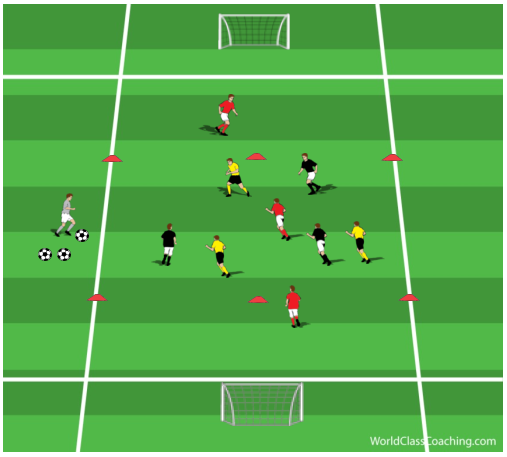
Possession Game with Finishing
By Alex Trukan
This practice has multiple challenges in all facets of the game. Firstly, from the conditioning point of view, it develops explosiveness and power. That is especially required when breaking through defences and around the opposition penalty box. From the technical perspective, it includes elements of passing, combination play as well as finishing. It also challenges players’ decision making on when to speed up play and try to score. Having an end product (shot on goal) makes it engaging and enjoyable for players. The practice is designed for intermediate and advanced players.
Set up and directions
Organise a 20 x 30 yards rectangle. Place two goals on the opposite ends, 15 yards away from the playing area. Divide the players into three teams of three. Two teams are positioned in the middle of the playing area and compete against each other. Third team is neutral, two players from that team are outside the area and one in the middle as shown on the diagram below. The neutral team plays with whichever team is in possession. Prepare a sufficient supply of balls.

The practice starts from the coach playing the ball to one of the attacking teams (not neutral). Which team starts with the ball can be adapted to the group needs and objectives of the session.
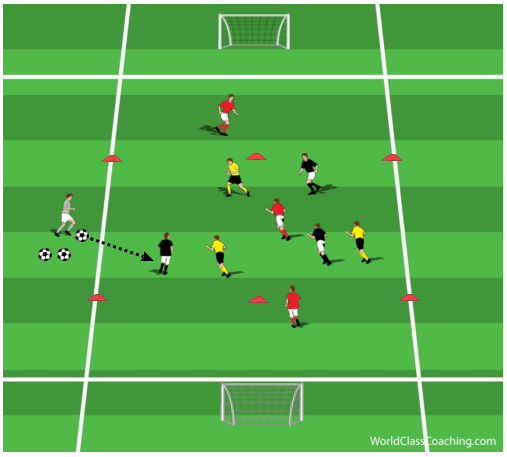
The team is possession then tries to make three passes before breaking through. The second team tries to get in possession with the same objective of making three passes. Neutral players support the team in possession of the ball.
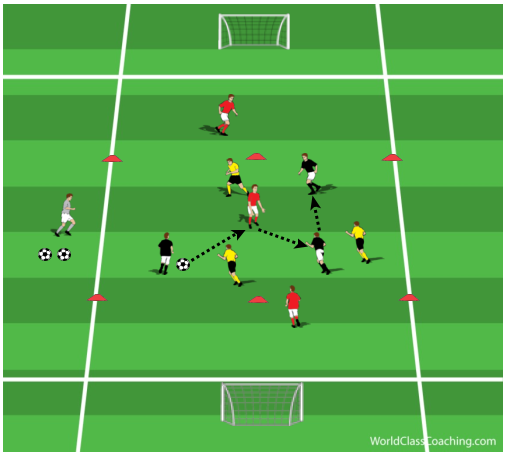
After the team makes three passes, they can play to any of the outside neutral players and break through to finish on goal. Minimum two players have to break through out of the square. The player that played the ball to the neutral player can’t be the one that finishes (forces third man run). The defending team can send out as many players as they want to stop the other team scoring. After the shot is made the practice is restarted from the coach playing the ball to the second team.
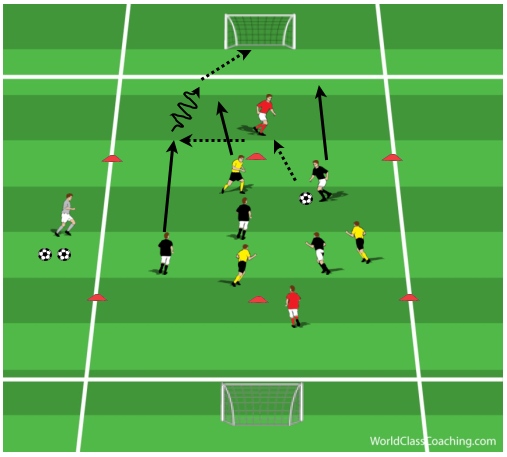
Timing
Both teams compete to ‘break’ 10 times. Every ‘break’ should last no longer than 3 seconds. That should be repeated in 2-4 series with 4 minutes break in between them.
Variations
- 4v4 in the middle
- 2 passes before the ‘break’
- Increase/decrease the distance between the playing area and goals
By Alex Trukan, Development Coach, Nottingham Forest
@AlexTrukan
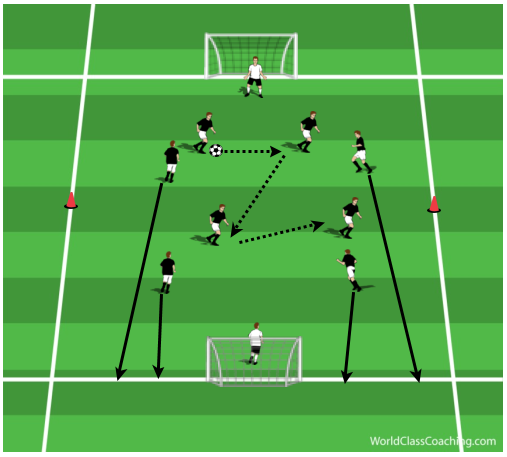
Small Sided Game to Improve Anaerobic Endurance
By Alex Trukan
The presented game is aimed at improving players’ ability to produce more high intensity actions throughout the game. This is achieved in a conditioned game which has elements of defensive transition, combination play as well as recovery runs. The organisation of this practices challenges players to react quickly when losing possession as well as combine play to attack upon winning it. This small sided game has some major tactical trade-offs, however the main area of focus is the physical corner. This practice is well suited for intermediate and advanced players.
Set-Up and Directions
Organise 30 x 40 yards pitch with two goals on the opposite ends. Mark out half way line. Divide the players into two teams of 4. Set goalkeepers in goals. The area size may be bigger if more players are involved. Prepare supply of balls.
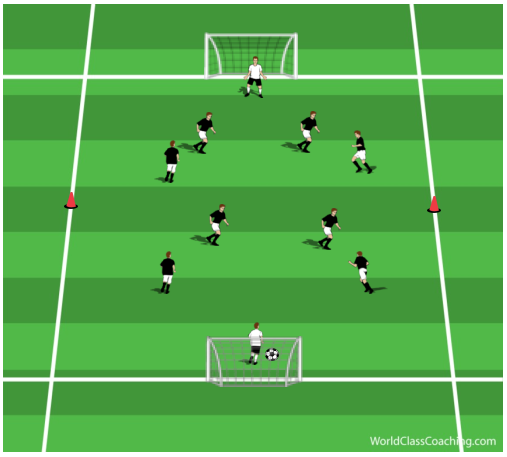
The game starts with a goalkeeper playing out to one of the players from his team. The aim of the team in possession is to score in the opposition goal. Normal rules of football apply.
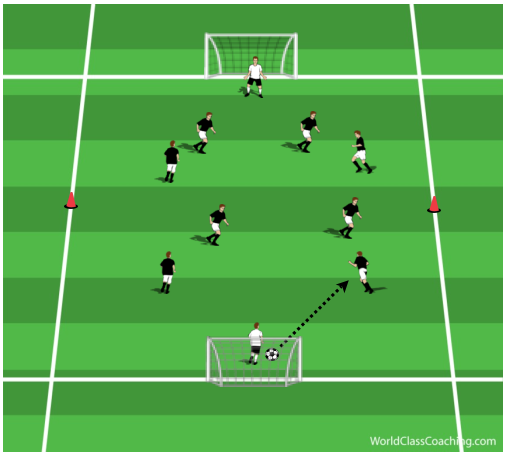
The condition of the game focuses on the moment of losing possession. If the attacking team loses the ball whether it’s after tackle or interception, all of the players from that team have to touch the line by their own goal before they can defend.
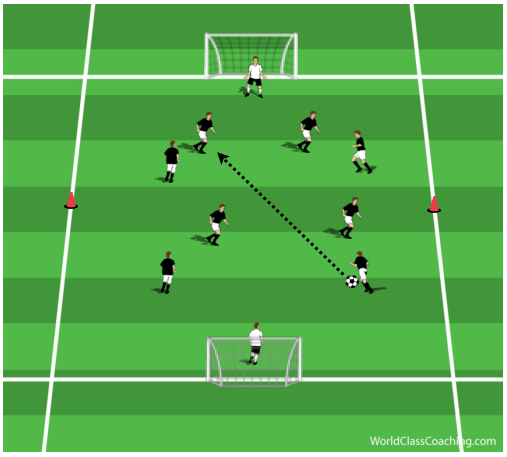
As we can see below, the reaction of the team that lost possession is to make a sprint towards own end line. The team that gained possession in turn, has to make 3 passes before they can attack and shoot.

The challenge for the defending team is to apply pressure on the attackers as soon as possible to prevent shots on target and their progression forwards.
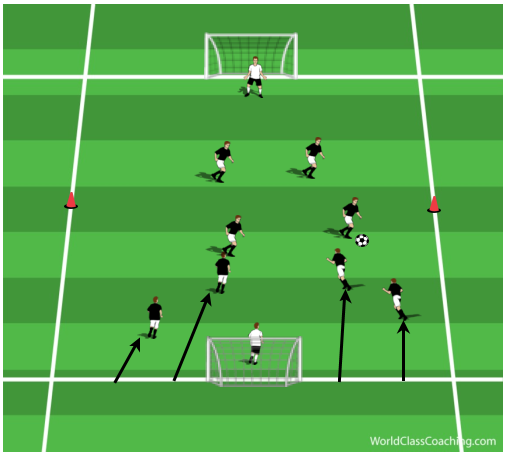
Timing
The game should be played 3 minutes and repeated 6-10 times in 2 series. The rest period between repetitions should be 1- 3 mins and between series – 4 minutes.
Variations
- 4 v 4/6 v 6
- Team that lost possession has to touch specific cone/line set by coach
- Team that won possession has to make 5 passes before making an attack
By Alex Trukan, Development Coach, Nottingham Forest
@AlexTrukan
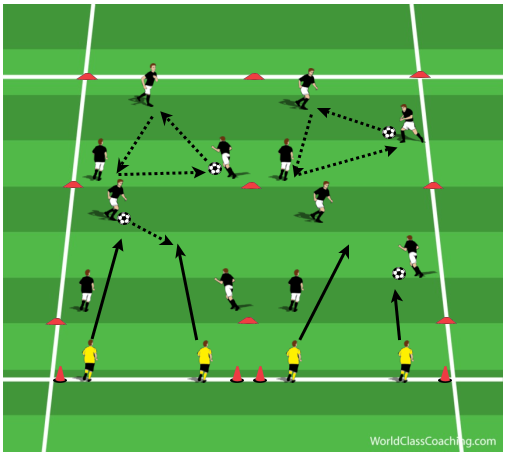
3 v 2 Competition
By Alex Trukan
This practice is designed to improve Anaerobic energy system which is responsible for short-duration, high intensity actions during a match. Therefore, players will develop their ability to produce high quality explosive bursts, which may be useful when applying pressure on the ball or doubling up to win the possession back. From the technical point of view, players involved in this practice also benefit from passing, movement off the ball and staying on the ball skills improvement.
Set Up and Directions
Organise four 6 x 6 yards squares positioned next to each other. That should form two ‘channels’ at the beginning of each, two additional cones should be placed as shown on the diagram below. Those two cones will be starting positions of the defenders. Divide the team into four groups of three and two pairs of defenders. Each group of three players should occupy one of the squares and have one ball between them. Two pairs of defenders should be positioned at the starting cones.
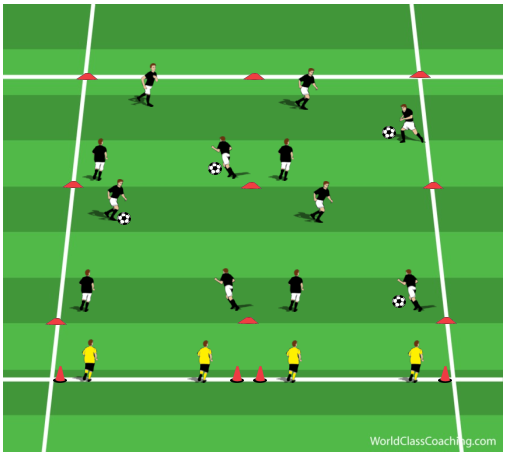
The practice starts with four groups starting to pass the ball in threes, changing positions and moving off the ball within their squares. The defenders are ready and waiting for the coach’s signal.
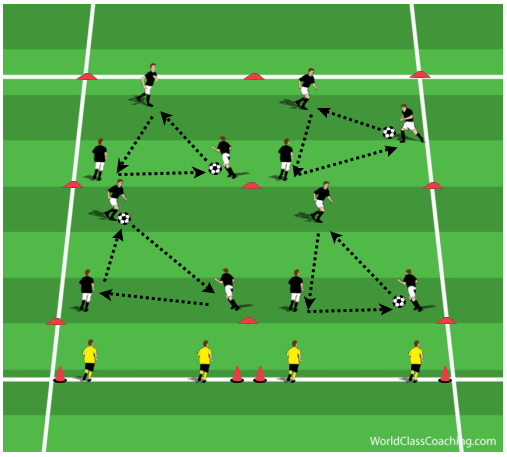

As soon as the defending pair manages to get the ball out of the first square, they should immediately sprint to the next one and try to do the same. Defenders can’t go into the second square before they get the ball out of the first one.
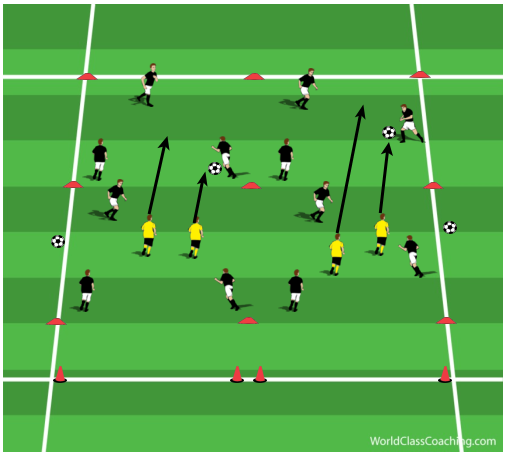
After getting the ball out of the both squares, defenders have to sprint back to their starting positions and flip the cone upside down. Whichever pair finishes doing that first, is considered a winner.
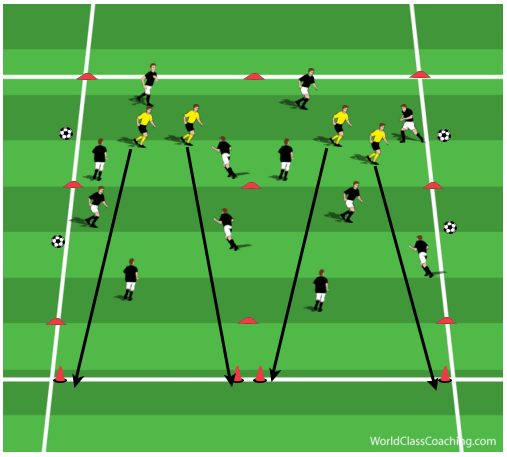
Timing
Each pair should make 4-6 repetitions in 1-2 series. The rest period between repetitions should be 1 minute and between series – 4 minutes (other players working).
Variations
- 4 players in each square
- Defenders have to dribble the ball out of the square/make a pass
- Two squares combined, four defenders working together – 6v4
By Alex Trukan, Development Coach, Nottingham Forest
@AlexTrukan
